 
|
||||
|
|
TOMMY CECIL AND NATE NAJAR |
|||
|
mwe3.com presents an interview with
Nate Najar: I was born in St. Petersburg, Florida. I actually currently live in downtown St. Petersburg about 5 blocks from the hospital where I was born! We have a fabulous arts community here, some very fine musicians and a great deal of cultural capital, wrapped up in a walk-able urban village. I especially like that I can walk to any gig that doesn’t require me to go to the airport! Florida as a whole has many ups and downs – the heat and humidity in late summer can be particularly brutal – but it’s home! I really do enjoy many aspects of European life however and cherish every moment I get to spend in the UK and continental Europe. If I could easily pick up and go live anywhere it would probably be Paris, for so many reasons. To be immersed in the sheer volume of culture and history there is very inspirational, and it’s such a delightful place to just “be.” While I would never presume to compare any place in Florida to such an iconic city as Paris, on a very micro level our little urban village has some of the same day-to-day delights, mainly in the form of a sidewalk café culture and a vibrant concentration of arts. mwe3: How did you and Tommy Cecil connect for the making of the American Melodies album? How long have you known each other and how did you decide on the songs that you wanted on the album? It's so good, I think you should consider a follow up! Nate Najar: I first met Tommy in 2004 when I was booked to play at the iconic jazz club Blues Alley in Washington, DC. Chuck Redd played vibes on the gig and he recommended I get Tommy to play bass. I like to say he’s ‘put up with me’ all these years. He has certainly watched me grow, and to be quite honest, he has been a major factor in my development as a musician. Through music and conversation, I learned a great deal about time, texture, touch and subtlety. The greatest thing I ever learned from Tommy is awareness. It is such a crucial attribute for a musician. Tommy is one of those musicians who, no matter what he plays, he makes the music better. He doesn’t “show off” or call attention to himself, he just - in the moment, there’s that awareness thing again, and without consciously thinking about it – plays with an intention to always support and elevate what is happening musically. I admire him more than I know how to express! Tommy has played in my trio off and on for many years and he is on my last few records. And we have played many, many gigs together over the years in all kinds of different places in all kinds of different musical situations. But this is the first duet album we’ve done together. It was also the hardest thing I’ve ever done musically. Classical guitar and upright bass with nothing else to shield, shade or hide behind – we were so exposed in that studio. Every little bad sound, squeak, bad note, missed note, you-name-it – you hear everything. Combine that with very difficult arrangements and you can imagine the stress! And we really wanted this record to have a particular aesthetic. I think we achieved it.
Over the course of a few months he would send me sketches of tunes he wanted to do and I’d play around with different arrangement ideas. The classical pieces are more heavily arranged of course and the jazz pieces range from heavily arranged to completely off the cuff. The music business is so upside down right now and the 2020 global pandemic has further twisted things that it seems the only reason to make an album like this is to make the album. I am extremely glad that we did it and we could probably be persuaded to do another one in the future mwe3: You mentioned Charlie Byrd as a big influence on your sound and style. When and where did you pick-up the guitar in the first place and what music and guitarists inspired you early on in your life? Were you always interested in playing jazz guitar and like Byrd, I imagine you were also inspired by a range of music and guitarists, from jazz to rock and classical too? Does rock or pop music still interest you or is it looked at as a composer’s vantage point? Nate Najar: Growing up in Florida, we went to Disney often. It was only an hour away back then in the days of no traffic! And it only cost something like twenty dollars to get in. So, you know how they have shows on every corner in the theme parks – with people singing and dancing etc… These days they’re all done to pre-recorded tracks. But when I was a kid there was a band playing every single show. And other musicians strewn about the parks playing on the pavement in virtually every corner. I didn’t care much for the dancing program but I was enthralled watching the musicians in the band playing the accompaniment. So, when I was 10 years old I asked my parents for a guitar for Christmas. At first I wanted to be Jimi Hendrix. Then I wanted to be Eric Clapton. Then I wanted to be Eddie Van Halen. And when I was 15, my 10th grade math teacher gave me a pair of dubbed cassette tapes – one of Wes Montgomery’s Smokin At The Half Note and the other was a Django Reinhardt compilation. That was it, I wanted to play jazz. I got with a fabulous teacher here in town, who sadly passed away in 2007, named Frank Mullen. Frank was originally from Washington, DC and he and Charlie Byrd were classical guitar students at the same time with the great DC teacher Sophocles Papas. Frank was the epitome of the cool 1960’s jazz musician and I wanted to emulate him so badly back then! He had moved to Florida in the early 70’s and started the guitar program at what was then called St. Petersburg Junior College. By the time I got to him in the late 90’s he was retired from the college and retired from playing. He taught at his house and maintained a very busy teaching schedule. The walls of his little teaching studio were covered in photographs from back-in-the-day - gigs with Charlie Byrd, Herb Ellis, Barney Kessel, Howard Roberts - just amazing stuff. And Frank told me to go get a classical guitar and we would do our lessons on that instead of the electric. We did a lot of fingerstyle chord-melody solo guitar playing and also a fair amount of classical repertoire like Villa Lobos and Sor. When I really discovered how poetic is the sound of the classical guitar I decided I was going to play this instrument. But I still wanted to swing! I voraciously collected any recording of Charlie Byrd I could find and to this day, when I hear a recording of Charlie playing a tune, I feel like “that’s the right way to do it.” He had such an elegant charm about his playing – there’s such an honesty of communication that can sometimes be missing from guys who play in a more “hip” fashion. Regarding repertoire, I love music. I love, love, love music. I love drama in music. I love honesty of communication and a sense of time and feeling. I love texture. I love melody and elegant voice leading. I love a sense of aesthetic – music that says “I am this” whatever “this” may be. As long as it does these things, I don’t care what genre you call it, I’m going to like it. Nate Najar: With the exception of the repertoire, which Tommy solely selected, and the technical aspects, which I solely performed, we basically shared the musical duties. Tommy had final say on anything because this was his project and I just tried very hard to not let him down! mwe3: What guitars are you playing on the American Melodies album? Are you a guitar collector and what is it about the guitar you play on American Melodies that makes it special? Tell us about your different guitars and how your choice has changed or evolved over the years? Nate Najar: I played 2 different guitars on American Melodies and I cannot remember which I played on which tunes, although I could tell by listening to them. One is Charlie Byrd’s 1972 Ramirez 1a and the other is my 1957 Kohno. The Kohno has a particularly elegant and charming sound that was perfect for certain things – I do recall definitely playing it on the Ned Rorem “Romance Without Words.” This Kohno is also the easiest guitar in the world to play and it is unbelievably responsive. The notes just jump off of the soundboard. Charlie’s Ramirez on the other hand, has a sound as big as a house – it’s a particularly good sounding specimen of a Ramirez, but it’s so hard to play. For those who don’t know about mid-century Ramirez guitars, per Segovia’s specification they were made for a number of years with a longer scale, wider and thicker neck and larger body. And on this particular guitar you can drive a truck underneath the strings! I have another Ramirez which is now my main performing guitar – it’s identical in dimensions to my Charlie Byrd guitar but it’s from the early 1980’s and it’s actually very easy to play. The string height is very comfortable and there’s even room to go up and down with it as tastes require. I don’t think of myself as a collector and don’t intend to be one, but I seem to have amassed quite a few guitars! I have a number of electric guitars as well, which I don’t really use professionally except maybe for a record date or something, but I do like to noodle on an electric with a pick every now and then. It reminds me of being 13 again! mwe3: How would you describe your guitar technique? Do you use a traditional classical finger style of playing and how do you combine your classical techniques and style with your love of jazz and pop music classics?
mwe3: The selection of tracks on American Melodies is excellent. What is so interesting was the choice of material in that most of these tracks, while being historical in nature, are not very well known. Possibly, with the exception of the Billy Joel track “The Longest Time”, which is still pretty popular. Was there a parameter by which you and Tommy decided on what songs to cover on the new album? Nate Najar: Tommy selected all the material. He wanted to do repertoire that was meaningful to him in some way and he tied it together with the theme of American composers. I think it was a brilliant idea. mwe3: Can you tell us something about the way American Melodies was recorded? It sounds like you are both in the same room together. Was the album recorded live and also were there some overdubbing on the album? Did you record right into the board and what helped get the album such a clean and clear sound as it happens on CD? Nate Najar: I have a little studio here in town that I use for my personal projects, things I’m producing, etc… Tommy first worked there when we did my album Under Paris Skies. He liked the sound I got so much he wanted to come down here for American Melodies. We were in the same room, basically facing each other. Just one microphone on each of us and a short gobo in between us. We were so close that we didn’t need to use headphones! There was no overdubbing at all but of course a few things required multiple takes to really tighten up. My recording philosophy is that the musician, the instrument and the room make the sound and it’s up to the engineer to capture that with no deleterious effect. I have a fairly high end and pristine signal chain, beginning with the microphones, and I just tried very hard to capture what we were presenting and try to get it to translate out of a pair of speakers. I’m really pleased it came out as well as it did.
Nate Najar: Most of my recorded work is out of print at this point, and with the death of the CD and the upside-down nature of the music business - and now the pause of live music from the global pandemic - who knows what the future might hold! American Melodies is the 15th album out under my name and definitely the work I’m most proud of to date. I am forever grateful to Tommy for asking me to do the project with him. mwe3: What has been the response to American Melodies so far? How are you coping with the 2020 pandemic and what are you looking forward to in 2021? It’s been so hard for the music community with all the clubs closed and live performances have moved online but it’s still not the same. I guess I will keep my mask handy but I would sure like to see musicians get back out in front of their audiences again. Can you make any forecasts for the future? Nate Najar: American Melodies managed some very positive reviews and we had a handful of very nice gigs lined up to support the album – Mezzrow in NY, Blues Alley in DC, some concerts in halls down here – and the pandemic put the kibosh on all of it. I’ve stayed busier than ever during the pandemic – my girlfriend Daniela Soledade is a wonderful bossa nova singer from Rio and her career has been my main musical focus lately. We’ve been doing a weekly hour-long livestream concert every Friday evening from our balcony since the pandemic began. It started because on March 20 we were booked to play “Nate Najar’s Jazz Samba Celebration” at the Palladium Theater, which is home base for us. It’s a gorgeous 800 seat theater where I’ve been performing for years, and I live right across the street!
I’ve also been an artistic adviser to the board for the Suncoast Jazz Festival (www.suncoastjazzfestival.com) for the last 5 years or so and this year, being the 30th anniversary, we didn’t want to go silent, so I am helping to produce a virtual festival. The musicians will be scheduled and performing from all parts of the world and it’s a very ambitious project that I’m equally excited and terrified about! The virtual festival will stream on Nov 20-22. I wish I had a crystal ball to see our future, but in the absence of that I am trying to keep an understanding of what the landscape looks like and how it is evolving right now so that when we settle into some new version of normal I can be best prepared to participate. But the bottom line is that I simply cannot wait to play for an audience again.
|
|
|||
|
||||

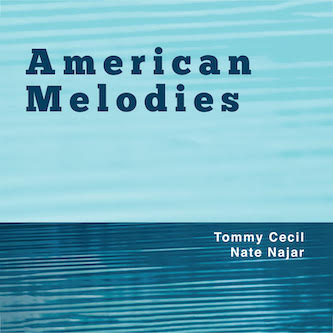 Florida-based nylon-string jazz-centric guitarist Nate Najar and jazz bass icon Tommy Cecil released American Melodies in 2019 and it is surely an album that jazz disciples will want to hear. For this 13-track, 65-minute album, Nate’s unamplified classical string guitar neatly teams with jazz bass ace Tommy Cecil, and together they join forces on a jazz duo album that offers fresh perspectives of timeless music composed by jazz icons such as the Gershwin brothers, Benny Golson, Duke Ellington, Thad Jones, and Billy Joel among others. Their version of the Billy Joel classic "The Longest Time", from 1983, turns it timeless. The rub here is, though these may be songs out of the collective past, literally, that the casual jazz fan may not know, surely these composers represent not only the best in jazz history but also the finest in American music. In-the-know jazz buffs and music historians may have heard this music yet, the rediscovery of these lesser-known nuggets from the great American songbook is one of the best parts of hearing it. Tommy Cecil is considered an American jazz icon that Nate first regarded among his musical heroes. Speaking of Nate’s exquisitely executed nylon-string guitar work and overall musical acumen, Tommy adds, “His growth has been dramatic. He's really worked hard, and it shows. I love playing with him. He really did his homework for this record and I'm knocked out at what he played.” Tommy Cecil further explains the album’s mission, “So American Melodies has a subtext: I'm symbolically putting forward to a younger generation - personified by Nate - repertoire that I learned from my elders.” Bottom line here is that American Melodies is one of the finest albums of the past year. The copyright on the back of the CD cover may say 2019, yet American Melodies is a timeless album that would be an instant classic in 1960 or 2020.
Florida-based nylon-string jazz-centric guitarist Nate Najar and jazz bass icon Tommy Cecil released American Melodies in 2019 and it is surely an album that jazz disciples will want to hear. For this 13-track, 65-minute album, Nate’s unamplified classical string guitar neatly teams with jazz bass ace Tommy Cecil, and together they join forces on a jazz duo album that offers fresh perspectives of timeless music composed by jazz icons such as the Gershwin brothers, Benny Golson, Duke Ellington, Thad Jones, and Billy Joel among others. Their version of the Billy Joel classic "The Longest Time", from 1983, turns it timeless. The rub here is, though these may be songs out of the collective past, literally, that the casual jazz fan may not know, surely these composers represent not only the best in jazz history but also the finest in American music. In-the-know jazz buffs and music historians may have heard this music yet, the rediscovery of these lesser-known nuggets from the great American songbook is one of the best parts of hearing it. Tommy Cecil is considered an American jazz icon that Nate first regarded among his musical heroes. Speaking of Nate’s exquisitely executed nylon-string guitar work and overall musical acumen, Tommy adds, “His growth has been dramatic. He's really worked hard, and it shows. I love playing with him. He really did his homework for this record and I'm knocked out at what he played.” Tommy Cecil further explains the album’s mission, “So American Melodies has a subtext: I'm symbolically putting forward to a younger generation - personified by Nate - repertoire that I learned from my elders.” Bottom line here is that American Melodies is one of the finest albums of the past year. The copyright on the back of the CD cover may say 2019, yet American Melodies is a timeless album that would be an instant classic in 1960 or 2020. 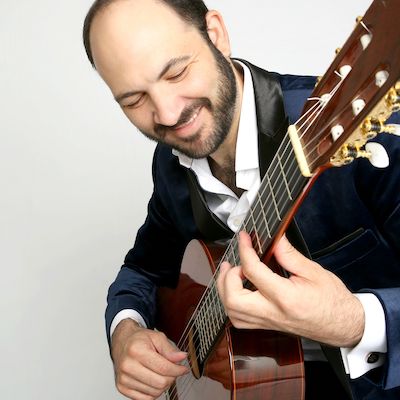 mwe3: Nate, can you tell us where you’re from originally and where you live now and what you like best about it? I know you’re based in Florida these days. Can compare living in Florida with other states and cities and even countries you’ve visited in and lived in?
mwe3: Nate, can you tell us where you’re from originally and where you live now and what you like best about it? I know you’re based in Florida these days. Can compare living in Florida with other states and cities and even countries you’ve visited in and lived in? 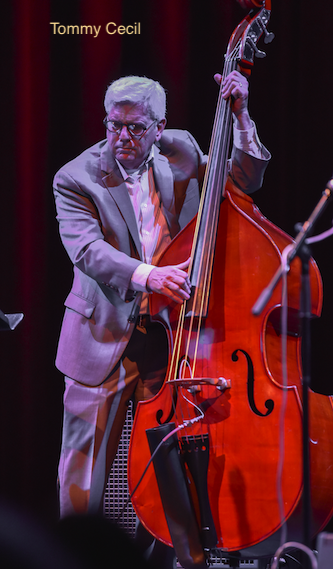 The entire thing was Tommy’s idea. He did a pair of brilliant duet albums with the legendary pianist Bill Mays – both albums were interpretations of the music of Stephen Sondheim. The duo concept is so brilliant because it is a genuine conversation. He wanted to do another duet project with a varied repertoire that was meaningful to him. On my last trio album, “Under Paris Skies,” we did a duet of the great Fauré piece “Après un Rêve.” I worked out the piano part on guitar and he played the soprano part on pizzicato bass. It was hard! And very rewarding. So, when he wanted to do another duo project, he decided to see if we could expand on what we did with that one recording of mine.
The entire thing was Tommy’s idea. He did a pair of brilliant duet albums with the legendary pianist Bill Mays – both albums were interpretations of the music of Stephen Sondheim. The duo concept is so brilliant because it is a genuine conversation. He wanted to do another duet project with a varied repertoire that was meaningful to him. On my last trio album, “Under Paris Skies,” we did a duet of the great Fauré piece “Après un Rêve.” I worked out the piano part on guitar and he played the soprano part on pizzicato bass. It was hard! And very rewarding. So, when he wanted to do another duo project, he decided to see if we could expand on what we did with that one recording of mine. 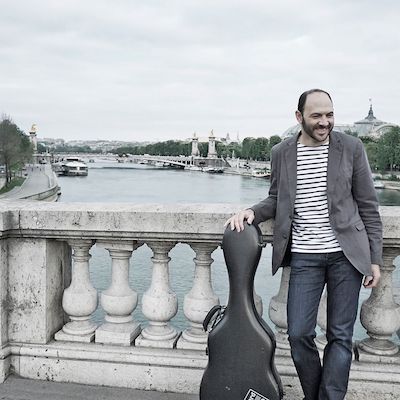 mwe3: What roles were assigned on the album? You and Tommy Cecil both arranged, while you recorded and mixed, and Tommy also produced. How did that arrangement of roles help bring the album to such a high level of excellence?
mwe3: What roles were assigned on the album? You and Tommy Cecil both arranged, while you recorded and mixed, and Tommy also produced. How did that arrangement of roles help bring the album to such a high level of excellence?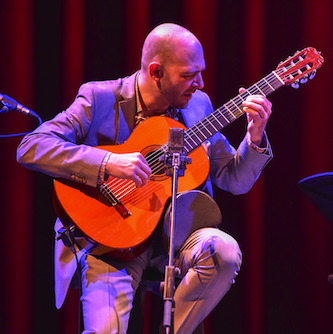 Nate Najar: I try to play with a “correct” a classical technique as I can for a few reasons. One is longevity – I don’t want any hand problems as I age – and the other is because I am trying to get a good sound out of the instrument. That said, technique for me has been a very fluid and evolving thing. And being an improviser can lead to using some very inefficient fingerings with either hand and that can really impact the sound you make. But playing an instrument is a life-long process and I don’t think anyone should wait until they have nothing else to learn to begin making music. The process and the journey is the point of the whole thing!
Nate Najar: I try to play with a “correct” a classical technique as I can for a few reasons. One is longevity – I don’t want any hand problems as I age – and the other is because I am trying to get a good sound out of the instrument. That said, technique for me has been a very fluid and evolving thing. And being an improviser can lead to using some very inefficient fingerings with either hand and that can really impact the sound you make. But playing an instrument is a life-long process and I don’t think anyone should wait until they have nothing else to learn to begin making music. The process and the journey is the point of the whole thing! 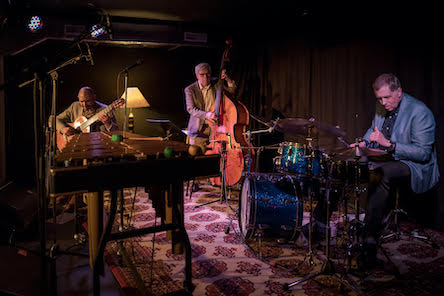 mwe3: How many albums have you recorded and released over the years? Are they still out on CD? I remember writing about your music on mwe3.com and 20th Century Guitar magazine back in 2003, that album you made with “Dreamsville” and “Battle Hymn Of The Republic”!
mwe3: How many albums have you recorded and released over the years? Are they still out on CD? I remember writing about your music on mwe3.com and 20th Century Guitar magazine back in 2003, that album you made with “Dreamsville” and “Battle Hymn Of The Republic”! 